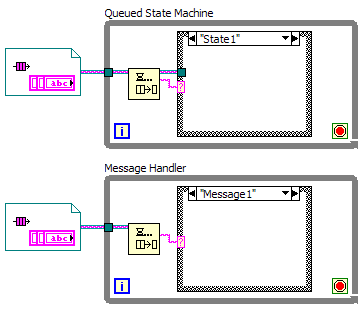Leaderboard
Popular Content
Showing content with the highest reputation on 07/17/2010 in all areas
-
I suppose "great" depends on what you're trying to accomplish and what kind of architecture your application has. The solution to that specific problem depends on the particulars. Who (meaning which part of the application) knows how to validate the entry? Who owns the help content? Who is responsible for the way the content is displayed? etc. If the answer to all these questions is "the dialog box," then a QSM will work, but hopefully you'll be aware of the limitations of the decision and can communicate those to your customer. If you haven't even asked those questions then I'll argue you haven't thought out your application's architecture well enough. Your question appears to assume I use single vis for my dialog boxes. I don't do that. My dialog boxes are classes. Why? Classes allow me to decouple the app's user interface from its functionality. Sometimes dialog boxes need to be shown in response to a user action, such as pushing a button. Sometimes they need to be shown because of something happening in the application, such as getting invalid measurement data. Using QSM dialog boxes scatters user interface code all over the functional code. Consider this: Suppose you've created an automated test app that has all sorts of dialogs for status updates, warnings, prompts for locations to save files, etc. It's just what the customer asked for. A month later he comes back and says, "You know what? We need an option that allows advanced users to disable the status update and warning dialog boxes." How do you apply this change? Probably by creating a UserType {Beginner | Advanced} enum and adding it to a supercluster of data that is carried through your app. Dialog boxes are shown or not shown during execution based on the enum. Kind of a pain, but not insurmountable. Probably the kind of change you expect to do as a developer. Then he comes back and says, "We need an option to run in unattended mode. Status updates and warnings should be saved to a log file. In this mode data will be saved on the network share." Okay, now we have UserType {Beginner | Advanced | Unattended}, probably add a LogFileDirectory to the supercluster, and we change around the functional code to deal with the new requirements. Unfortunately the requests keep coming... "Sometimes the network is down. The data needs to be saved locally if that happens." "We want the option to save data in text format or as an .xls report." "One of our operators can't see very well. Can you create a 'High Contrast' option?" Q: What do all these requests have in common? A: None of them affect the test execution logic in any way, yet will likely require changes to your test execution code in order to implement. I have a hard time considering an implementation "great" if it includes these limitations. I have no idea what that means, but it sounds disgusting. So if it's a sequencer, what is it you're sequencing? I've said it before, but I think the terminology is extremely important. Message handlers, sequencers, and state machines all have very different purposes and are not interchangable. Failing to distinguish between them creates a lot of confusion about what role that bit of code is supposed to fulfill. In my opinion this diagram illustrates the key difference between a QSM and message handler. Not extending the message queue past the dequeue prim makes all the difference in the world. A message handler can't send messages to itself because there's no reason for it to do so. If I end up in a situation where the message handler needs to send a message to itself then there's a flaw in my design that needs to be addressed. Calling something a "first-class citizen" in a language usually means you can pass it as a parameter or assign it to a variable. So, while technically you are correct (while loops and case structures aren't first class citizens either) I'm pretty sure that's not what you meant. I'm open (but skeptical) to the idea of using a QSM as a fundamental building block, as long as it is very restricted in the scope of what it is asked to do. What I have seen most often is people attempting to use the QSM as an application architecture, a task it is entirely unsuitable for. But in order to convince me QSMs make good building blocks you'd need to start by answering the question I asked Jon earlier--How do you decide if a piece of functionality should be a case or a sub vi? More generally, how do you go from a flow chart (like the one from Ben I posted above) to a QSM implementation? I see these claims being made all the time about QSMs. Are they flexible? You bet! Jello is flexible too--that doesn't make it a good building material. Good building materials offer the right balance between flexibility and structure. QSMs are too flexible. There's no inherent structure helping to guide design decisions. Without structure it can't be scalable. You won't get far building a Jello house before it collapses under its own weight.1 point


